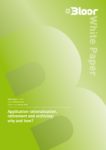Application rationalisation, retirement and archiving: why and how?
Date:
By: Philip Howard
Classification: White Paper
In IT terms, people want to consume applications on mobile devices, companies want to implement applications in the cloud, and organisations want to exploit social media for marketing and other purposes. At the same time, business people increasingly want self-service access to applications and analytics. The problem is that taking advantage of all of these capabilities requires money and resources, and it becomes a question of how IT can meet these demands while, at the same time, their budgets are under increasing pressure. How is this circle to be squared? How can IT deliver increased and improved services while reducing costs at the same time? The short answer is that they need to do what they do now more efficiently and one way that can be achieved is through application rationalisation. What we mean by this is that applications can be consolidated and/or retired and the data that is no longer required for operational purposes can be archived. This means reduced license and maintenance fees from application vendors, which in turn means reduced licensing fees and storage costs. In other words, you free up budget to use for the investments you need to modernise your IT environment. For example, we recently came across a company that had seven implementations of SAP. Six of these implementations were read-only. By archiving read-only data (which you can still read) you save significant sums.
In this paper we discuss how to approach application rationalisation and retirement, and related best practices. We also address the issue of reassurance: business users are often concerned that retiring applications will be damaging in some way. Done properly, this should not be the case.

